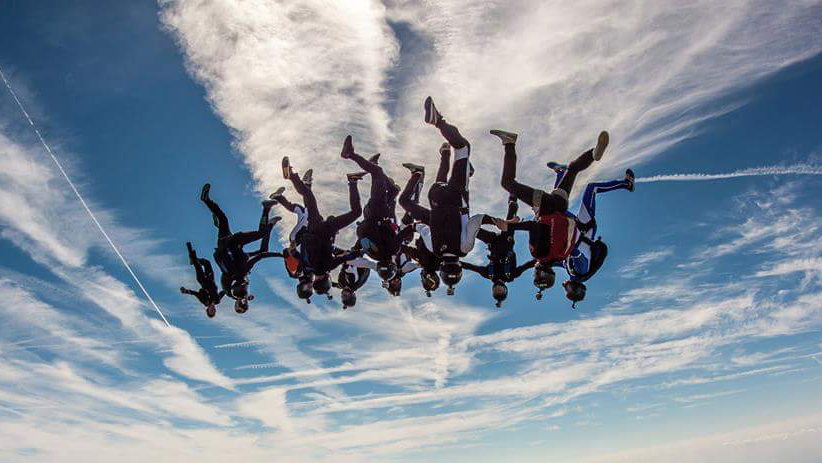Two experienced skydivers both having an AAD fire is not something that happens every day…

Back in 2015 Reinout De Clercq and Simon Hoorens were jumping together on a Sunday morning over Belgium and were still carving head-down at activation altitude. Reinout’s Cypres fired first and Simon’s unit a second later. Both jumpers walked away without serious injury.
The video tells the story…
Where in your skydiving progression were you at the time?
Reinout De Clercq: At the time I had been jumping for over five years and had around 600 jumps. When it happened we had been jumping all summer long – lots of big groups and big formations. We had been doing lots of both tracking and static flying.
Simon Hoorens: I had at that time around 2,000 jumps. I felt comfortable. I had just become an aff instructor a month before.
What do you remember about the jump?
Reinout De Clercq: We only planned to do one or maybe two jumps that morning, and then we were planning to go home. The first jump had the same plan but didn’t go quite well. It was not going to be a significant jump but we were excited about it.
The deployment was really, really hard – it was like being thrown at a wall at 200 miles an hour. There were not a lot of people at the dropzone, but they could all hear us because we were right over the top and the noise we made still carving so low was apparently quite loud. Yeah, we’re going fast. I think it was more than 300 kilometers per hour. I couldn’t believe what happened. It was really strange that I forgot to pull my parachute.
What happened after?

Reinout De Clercq: Of course we had to do the walk of shame to the hangar because everyone was watching. I could not feel any pain at first as I was so full of adrenalin, but I had broken my ribs and had bruises all over for sure. I did not realize properly until I got home that something was wrong, as I did not feel anything for the first hour.
Simon was uninjured – I think because his unit deployed one or two seconds later. He saw me and he went to his back enough that he slowed down some before his unit went off. I think that is why he didn’t get hurt, as he was a little slower than me and in a bit better position.
Simon Hoorens: After the incident, they grounded us for a month, and I was grounded as an AFF instructor for two months, which doesn’t make a lot of sense I guess. But yeah, that’s the way it was.
Reinout De Clercq: I didn’t mind showing people the video or talking about it, not at all. Simon was not initially too keen to show everybody, but even now years later it is still used for aff students to show what can happen with altitude awareness.
Simon Hoorens: I wasn’t ready right away to put it out there on the Internet but everyone on the dropzone could see it. Also, the video went around in Belgium, so everybody saw it and knew what had happened. It wasn’t a secret or anything like that.
What do you think made this happen?
Simon Hoorens: We were just too comfortable with our audibles, carving around and waiting for the beeps to come – but that is something you cannot do. You cannot trust just the audible.
We were just too comfortable with our audibles, carving around and waiting for the beeps to come”
SIMON
Reinout De Clercq: I think it happened because we had been jumping for the whole summer in big groups. You get used to separating when you see others start to break off, so I guess the reflex to go on your own was a bit relaxed.

Photo by Jean-Phillippe Ricordeau
Did anything change after this about the way you jump?
Simon Hoorens: It changed a lot. Before, I had just one audible, now I have two. At the beginning of the day I always check my audible to see if my battery is full. If it isn’t full. I make sure before every jump that the indicator is not flashing for a low battery. If it is I will change the battery before going up. The same for my visual altimeter – I will check it every time. In freefall now I will visually check my altitude – every time.
Reinout De Clercq: My skydiving itself did not change a lot because before this safety was already very important to me. I did start to put my audibles a bit higher and must say I often found myself the first to break off. When you first start skydiving you hear stories about other people – that they must have done something terribly wrong, and you believe that nothing can happen to you. This helped me to understand that even when you follow all the safety procedures something can go wrong. The longer you skydive the better you understand that it is dangerous and something can happen at any time.
How do you feel about it now?
Simon Hoorens: I still take it for a good lesson – for me and for everyone else out there. I don’t feel like it happened yesterday, because for the first week after the incident I was really freaked out. But I do remember it as if it was not a long time ago. Just a crazy thing. We never thought it could happen to us.
We never thought it could happen to us”
simon
Reinout de Clercq: The main reason for releasing the video again now is to help people. Of course AADs should be mandatory everywhere in the world, and for sure every skydiver should have two audibles at maximum volume. Also it is important to maintain awareness at all times and never get so excited that you lose exactly where you are. I don’t jump any more now and I miss all the guys I was jumping with. I really do.

Summarized
This story of Reinout and Simon’s jump is about the division of responsibility. When jumping in groups, relying on the visual signpost of everyone else breaking off as your key to do the same is something we all do to some extent. But it should only ever be a part of the information you use to maintain altitude awareness. Also, as demonstrated by this event it is very possible to miss hearing your beeps. All the things we employ – both wrist-mounted and audible altimeters, visual references, even our internal jump clock all add up to our overall precision.
Both Reinout and Simon were at the time experienced and current skydivers – in general terms and in the discipline they had chosen for this particular jump. Nothing in their previous behaviour pointed to this happening – yet it happened. Currency in skydiving contains within itself a kind of paradox. At times, feeling very confident and comfortable with the way you have been jumping can prevent you from examining the small details and important differences a minor change can create – such as when as a pair you both fly right through your beeps and neither jumper provides the other with a visual cue to leave. A couple of minor oversights that turn into a situation where you are both still flying head down close enough to the earth that the people on the ground look up to see what the strange noise is.
Currency in skydiving contains within itself a kind of paradox. At times, feeling very confident… can prevent you from examining the small details”
The process of sharing the details and information from an event like this – both locally and ultimately with everybody contributes to the onward progress of the technology we employ to help keep people safe while skydiving, and it is testament to the effort put in by skydiving manufacturers as a whole industry toward the safety and quality of the equipment we use that a situation such a this can happen and two people walk away with the most serious injury being a few broken ribs.
Article originally published on the Cypres Blog


